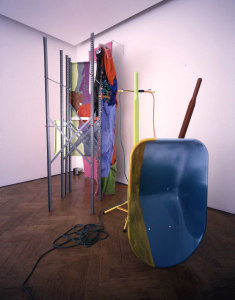ART-PREVIEW:Hybrid Sculpture
 The exhibition “Hybrid Sculpture” presents a selection of work from the Collection of Stedelijk Museum Amsterdam that reveals how radically sculpture has changed since 1990. The exhibition features 20 sculptures, most of them large-scale works, by nineteen artists. The title refers to the fact that almost none of the works looks like a sculpture in the traditional sense: the artists blur the boundaries between sculpture and painting, performance, video art and design.
The exhibition “Hybrid Sculpture” presents a selection of work from the Collection of Stedelijk Museum Amsterdam that reveals how radically sculpture has changed since 1990. The exhibition features 20 sculptures, most of them large-scale works, by nineteen artists. The title refers to the fact that almost none of the works looks like a sculpture in the traditional sense: the artists blur the boundaries between sculpture and painting, performance, video art and design.
By Efi Michalarou
Photo: Stedelijk Museum Archive
For the artists that their work is shown at “Hybrid Sculpture”, the aim is not to create a ‘pure’ sculpture informed by the classic sculptural properties such as volume and space. Instead, their practice centers around combining a variety of media and appropriating objects from pop culture and everyday life, transforming them by changing their size, color or material. The logos, symbols and other representations of post-capitalist aesthetics are the center of Marc Bijl’s work. Using the most appropriate medium for each situation – installations, sculptures, videos, (often illegal) public interventions, posters, stickers etc. – he formulates his own iconoclastic and subversive aesthetics, influenced by punk and goth subcultures, for instance, Marc Bijl’s “Suicide Machine” (2003) consists of a motorbike accompanied by the statement “Ready to Crash and Burn”. Magali Reus’s sculptures often resemble the furniture and equipment of modern domestic interiors and public spaces, most frequently functional objects such as fridges, seating, pots and pans. Interested in the graphic language of the objects that surround us, Reus identifies and makes use of formal qualities that carry specific associations, or invite what she calls “A kind of meandering emotional projection”. In “Abroath Smokie” (2016), Magali Reus uses fabric and leather processing materials to create sculptural forms that, while not directly referring to existing objects, still evoke associations with saddles, motorbikes and blankets. Jessica Stockholder’s sprawling constructions have played a crucial role in expanding the dialogue between sculpture and painting and form and space. Within her work, the artist merges seemingly disparate, everyday objects to create holistic, colorful installations. Stockholder employs quotidian goods such as plastic bags and containers, extension cords, lumber, plywood, carpets and furniture, drawing attention to the aesthetic and formal qualities of these often overlooked items while avoiding overt symbolism and narrative storytelling. With deliberate placement and the eye of a master colorist, she maps out a constructed world informed by numerous artistic traditions, including abstract expressionism, color field painting, installation art, and minimalism. Her large-scale assemblage “Coupling” (1998), consists of two contrasting parts: one lush and exuberant, with its profusion of color and textured materials and included carpet, rope, fur, blankets and clothing; the other cool and linear, made up of the graphic elements of metal shelving and threaded rod—a strategy closer to drawing than painting. A cable taken from a domestic heater links the elements. The installation by Jimmy Robert contains the remnants of a past performance, including a 19th Century gold-plated folding screen that served as a backdrop, stage and room divider, and mirrors worn by the artist during the performance. The “Schauspieler” series by Isa Genzken consists of extravagantly dressed mannequins in theatrical poses and setting. These “urban cowboys” and aliens”, as she calls them, could be extras from a futuristic film. For this series Genzken used garments from her own wardrobe and with the “Schauspieler” explored both the limits of the self-portrait and the boundary between private identity and public image. Thomas Hirschhorn is known for his sprawling works that transform traditional white cube spaces into absorbing environments tackling issues of critical theory, global politics, and consumerism. He engages the viewer through superabundance. Combining found imagery and texts, bound up in low-tech constructions of cardboard, foil, and packing tape, he props imagistic assaults in a DIY-fashion that correlates to the intellectual scavenging and sensory overload designed to simulate our own process of grappling with the excess of information in daily life. Created from the most basic everyday materials, his monumental works “Neighbours” (2002), are concerned with issues of justice and injustice, power and powerlessness, and moral responsibility.
The exhibition includes work by: Dorothy Akpene Amenuke, Marc Bijl, Rob Birza, Rosella Biscotti, Cosima von Bonin, Kerstin Brätsch, Keith Edmier, Isa Genzken, Thomas Hirschhorn, John Knight, Jeff Koons, Louise Lawler, Helen Marten, Tobias Rehberger, Magali Reus, Jimmy Robert, Jessica Stockholder and Cerith Wyn Evans.
Info: Curator: Leontine Coelewij, Stedelijk Museum Amsterdam, Museumplein 10, Amsterdam, Duration: 23/3/19-12/1/20, Days & Hours: Mon-Thu & Sat-Sun 10:00-18:00, Fri 10:00-20:00, www.stedelijk.nl




